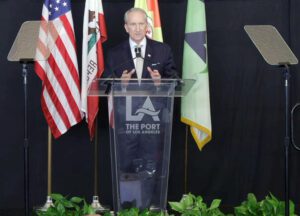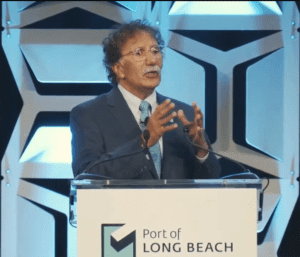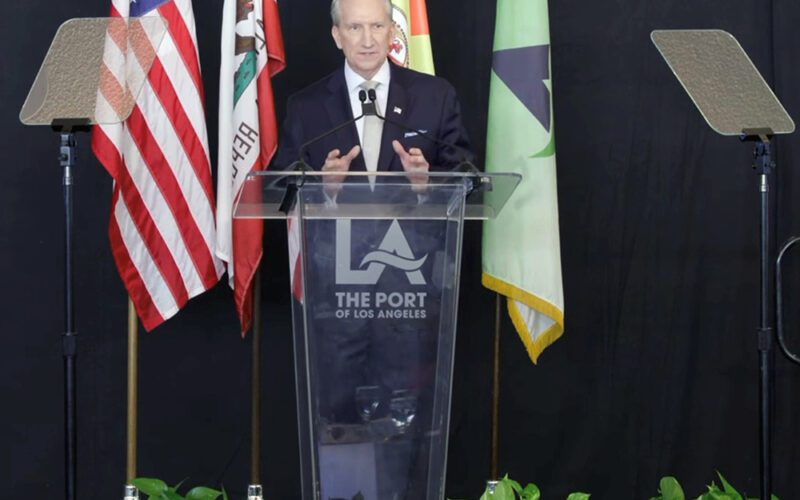
The leaders of the two of the three busiest seaports in North America in January outlined some of their goals and priorities for the year.
Economic growth, job creation and expanding zero-emissions operations are among the Port of Los Angeles’ goals for 2023 and beyond, port Executive Director Gene Seroka said during his annual ‘State of the Port’ speech on Jan. 19.
The State of the Port is an annual event put on by the port in conjunction with the independent, non-profit Pacific Merchant Shipping Association. This year’s event, held at the port’s cruise center terminal, attracted 510 attendees, according to the PMSA.
During his 35-minute speech, Seroka revealed that the POLA moved 9.9 million TEUs in 2022, the second-highest annual amount in the port’s 115-year history. The amount marks the 23rd consecutive year that Los Angeles has been the top port in the U.S., volume-wise.
Seroka said that the POLA intends to lead technology in the maritime industry to drive efficiency. In line with those efforts, he commented, were new features being added to the POLA’s Port Optimizer digital tracking portal, including the providing of exporters with more predictability and tracking capability on outbound shipping services.
“Data infrastructure gives us tremendous insight into supply chain issues, trends and process improvement opportunities which were simply not available before,” he said. “These new tools will add to the stability and growth of America’s global trade.”
Additionally, he said that work would continue this year on development and deployment of zero-emission cargo handling and other equipment, as well as additional deployment of additional zero emission and low emissions drayage trucks.
Seroka also said that the port is part of a statewide coalition that will apply for a $1.4 billion U.S. Department of Energy grant to establish a green hydrogen hub at the LA-Long Beach port complex.

At the Port of Long Beach’s ‘State of the Port’ address, held Jan. 26 at the Long Beach Convention Center, port Executive Director Mario Cordero said that Long Beach is working to become the world’s first zero-emissions seaport.
The event, which was the first in-person State of the Port address since 2020, following two years of virtual events due to the COVID-19 pandemic, attracted more than 700 attendees, port officials told Pacific Maritime.
During his 50-minute speech and video presentation, Cordero committed to supporting state and federal efforts to increase renewable energy sources, and called 2023 the “Year of Imagination.”
Among the planned projects, Cordero said, is a bid to assemble and manufacture offshore wind turbines that will increase the state’s supply of renewable energy and reduce greenhouse gas emissions.
He also called on companies with strong environmental policies to choose the Port of Long Beach when shipping their goods and materials.
The POLB is also establishing a Zero Emissions, Energy Resilient Operations Program—known as ZEERO—to invest in projects aimed at reducing the impacts of operations and improving air quality.
Cordero said that ZEERO’s goals include supporting the development of renewable energy projects, including the port’s proposed Floating Offshore Wind Staging and Integration facility, known as “Pier Wind.”
A conceptual assessment for Pier Wind is scheduled for completion in spring 2023. Cordero said that the facility would aim to become the largest facility specifically designed to accommodate the assembly of offshore wind turbines at any U.S. seaport.
Turbines assembled in Long Beach would be deployed to wind farms off the coast of Central and Northern California. The project would help California meet a goal of producing 25 gigawatts of offshore wind power by 2045, in addition to creating jobs and economic opportunities for communities near the San Pedro Bay port complex.
The Port of Long Beach ended 2022 with 9.13 million twenty-foot equivalent units moved, down 2.7% from 2021, which was the most active year in Long Beach’s 112-year history as a seaport.
The POLB ended 2022 as the third-most trafficked seaport in the country last year, after Los Angeles’ 9.91 million TEUs and the Port of New York-New Jersey, which moved 9.49 million TEUs.

